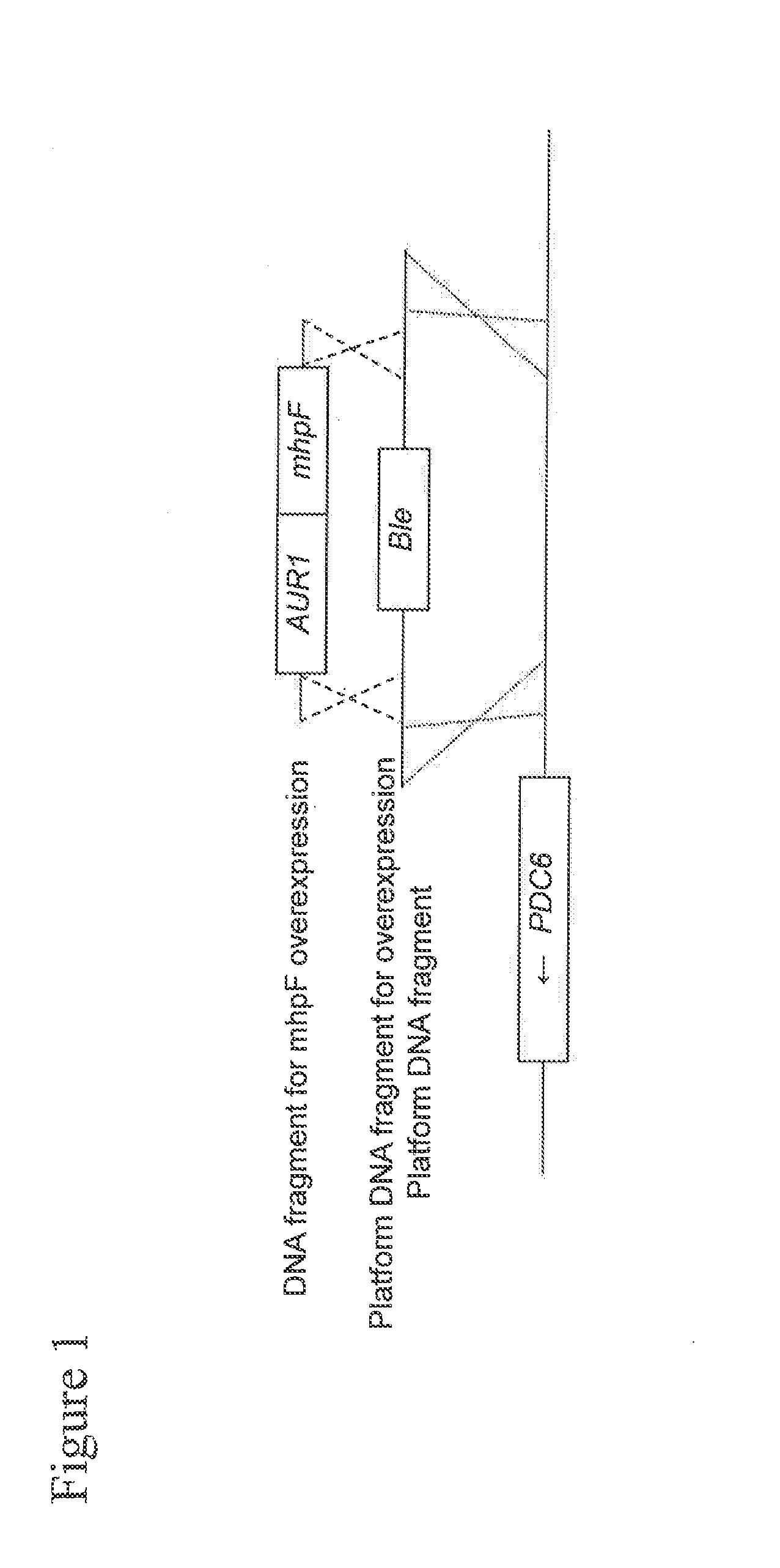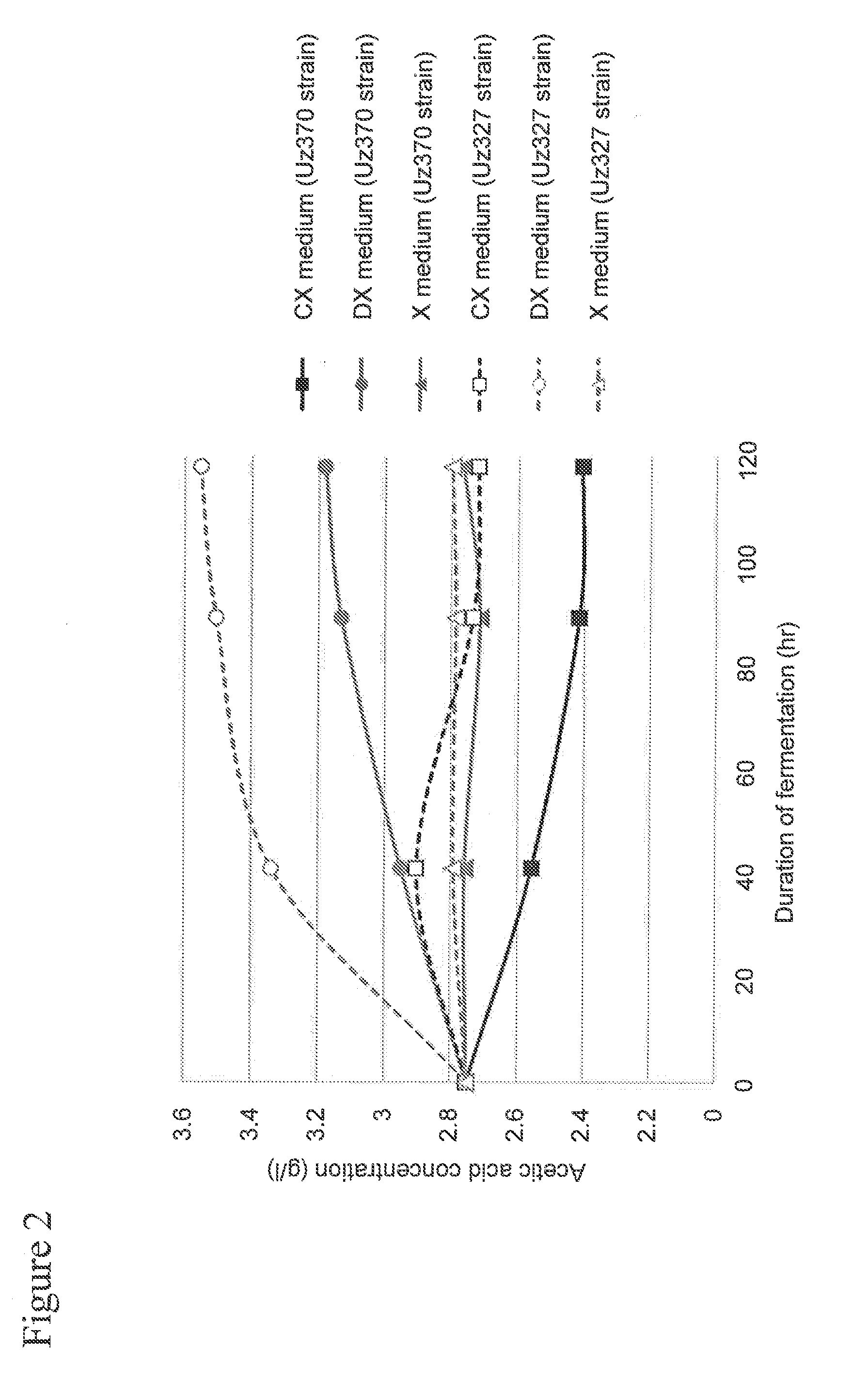Method for producing ethanol using recombinant yeast
a technology of recombinant yeast and ethanol, which is applied in the field of recombinant yeast production methods, can solve the problems of inhibiting ethanol fermentation, difficult removal of acetic acid from the mash, and the effect of ethanol fermentation conducted with the use of xylose substrate, so as to achieve the effect of reducing the concentration of acetic acid in the medium, avoiding inhibition of acetic acid fermentation, and maintaining high efficiency of ethanol fermentation
- Summary
- Abstract
- Description
- Claims
- Application Information
AI Technical Summary
Benefits of technology
Problems solved by technology
Method used
Image
Examples
example 1
[0081]In Example 1, a recombinant yeast strain was prepared through introduction of an acetaldehyde dehydrogenase gene derived from E. coli (the mhpF gene) into a xylose-assimilating yeast strain, and acetic acid metabolizing ability of the recombinant yeast strain was evaluated.
[0082]With the use of the plasmid prepared in Reference Example 1 described in detail below, pCR-T_HIS3-P_TDH3-AUR1-C-P_TDH2-IDP2m-T_IDP2-PDC1part, as a template, a DNA fragment excluding the promoter region of the TDH2 gene and the IDP2 gene was amplified by PCR. A pair of PCR primers TB2158 (5′-ACCCGTGGCTGCGAGCGACCAGCTAACTTGGTCGAC-3′: SEQ ID NO: 3) and TB2797 (5′-CCTCATTGCTGGATAGAGCCTCATCG-3′: SEQ ID NO: 4) was used.
[0083]Separately, a DNA fragment containing a terminator region of the ERO1 gene and a DNA fragment containing a promoter region of the HOR7 gene were amplified using the genome of the OC2 yeast strain (NBRC2260) as a template. These primers used for PCR were designed with reference to the DNA ...
reference example 1
[0090]In Reference Example 1, a process for preparing pCR-5U_PDC6-T_HIS3-P_TDH3-Ble-T_URA3-PDC1part-5U_PDC6 used in the examples is described. At the outset, a DNA fragment containing a 5′ upstream untranslated region of the PDC6 gene and a part of the PDC6 gene was amplified using the genome of the OC2 yeast strain as a template, the amplified fragment was subjected to cloning with the use of the Zero Blunt TOPO PCR Cloning Kit, and the resultant was designated as pCR-5U_PDC6. A pair of PCR primers TB0948 (5′-GTTGAAGTCGCCTGGTAGCC-3′: SEQ ID NO: 15) and TB0735 (5′-CGGTGATCCCCTTGAAAAAG-3′: SEQ ID NO: 16) was used.
[0091]Also, a DNA fragment containing a terminator region of the HIS3 gene, a DNA fragment containing a promoter region of the TDH3 gene, a DNA fragment containing a terminator region of the URA3 gene, and a DNA fragment containing a part of the PDC1 gene were amplified by PCR using the genome of the OC2 yeast strain as a template.
[0092]The DNA fragment containing a terminat...
reference example 2
[0101]In Reference Example 2, a process for producing a strain resulting from heterozygous introduction of XYL1, XYL2, and XKS1 gene overexpression and GRE3 gene disruption into a homothallic diploid yeast strain; i.e., the Saccharomyces cerevisiae OC2-T strain (Saitoh, S. et al., J. Ferment. Bioeng., 1996, Vol. 81, pp. 98-103), is described.
[0102]A DNA fragment containing the GRE3 gene and its 5′ upstream and 3′ downstream untranslated regions was amplified by PCR using the genomic DNA of the BY4742 yeast strain (Open Biosystems) as a template. A pair of PCR primers TB2358 (5′-TGGGAATATTACCGCTCGAAG-3′: SEQ ID NO: 40) and TB2359 (5′-AAGGGGGAAGGTGTGGAATC-3′: SEQ ID NO: 41) was used. PCR primers used for amplification of the DNA sequence of the BY4742 yeast strain were designed with reference to the DNA sequence data stored in the Saccharomyces Genome Database. With the use of the pUC19 plasmid as a template, a linear DNA fragment containing full-length pUC19 that seemed to have been ...
PUM
| Property | Measurement | Unit |
|---|---|---|
| width | aaaaa | aaaaa |
| pH | aaaaa | aaaaa |
| OD | aaaaa | aaaaa |
Abstract
Description
Claims
Application Information
 Login to View More
Login to View More - R&D
- Intellectual Property
- Life Sciences
- Materials
- Tech Scout
- Unparalleled Data Quality
- Higher Quality Content
- 60% Fewer Hallucinations
Browse by: Latest US Patents, China's latest patents, Technical Efficacy Thesaurus, Application Domain, Technology Topic, Popular Technical Reports.
© 2025 PatSnap. All rights reserved.Legal|Privacy policy|Modern Slavery Act Transparency Statement|Sitemap|About US| Contact US: help@patsnap.com



